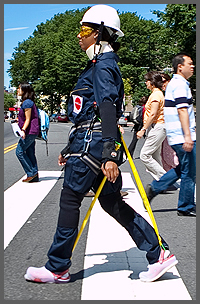Oct30
CVS and Ford: Putting Designers in Customers’ Shoes – literally
Point: To design better for customers, put yourself in their shoes.
Story: What’s it like to drive a car if you can’t turn you head easily to look over your shoulder? Or to shop, if bending over hurts and the product you want is on the bottom shelf?
That’s what older drivers feel, and every minute in the US, one person turns 66. In seven years, the US will have 55 million people over age 65 — a big market.
people over age 65 — a big market.
To better design for the needs of this market, companies like pharmacy chain CVS are putting themselves in the shoes of aging customers with AGNES. AGNES stands for “Age Gain Now Empathy System.” Developed by the MIT AgeLab, AGNES is a specially-designed jumpsuit that mimics what it feels like to be in your mid-70s. The suit can be be worn by designers, product developers, architects and planners to experience firsthand the physical challenges associated with aging. For example, bungee cords anchored to the helmet and hip restrict movement and rotation of the spine, and elastic bands from hit to wrist reduce shoulder mobility.
CVS will be making store design changes based on learnings from the suit. For example, they’ll be putting carpeting in the stores to reduce slick-floor slipping, and they’ll adjust the height of checkout counters to require less bending and lifting.
Similarly, Ford Motor’s engineers use a similar suit (they call it the “Third Age Suit”) to experience driving with restricted movement and dexterity in hands, knees, neck and even eyesight (goggles simulate cataracts). Ford also has a bulbous weighted “empathy belt” that simulates the physical effects of pregnancy. All of these inventions help give designers a better sense of the consumer’s experience of the company’s products and services.
The result: not only will product designers develop better products for the elderly, but their innovations — like Ford’s hands-free automatic parallel-parking system — appeal to consumers of all ages. Simplicity, ease and comfort attract customers of any age.
Action:
- Create tools or prostheses that simulate the customer’s experience of the product or service
- Test products and services for ergonomics for a wide range of customers (especially the growing population of those over 65)
- Look for win-win design solutions that improve usability for everyone.
Sources:
MIT AgeLab: AGNES (Age Gain Now Empathy System): http://agelab.mit.edu/agnes-age-gain-now-empathy-system
Future Demographics – The Silver Book: http://www.silverbook.org/browse.php?id=57
Interview with Dr. Joseph Coughlin on AGNES and the AgeLab: http://web.mit.edu/newsoffice/2009/coughlinqaa-0414.html
In An Aging Nation, Making Stores Senior-Friendly
http://www.npr.org/2011/05/10/135773106/in-an-aging-nation-making-stores-senior-friendly
In a Graying Population, Business Opportunity
http://www.nytimes.com/2011/02/06/business/06aging.html?pagewanted=all&_r=0
A Profile of Older Americans: 2011 – Administration on Aging: http://www.aoa.gov/aoaroot/aging_statistics/Profile/2011/docs/2011profile.pdf
Comments Off on CVS and Ford: Putting Designers in Customers’ Shoes – literallyCase study, Customers, How-to, Innovation, New Product Development











